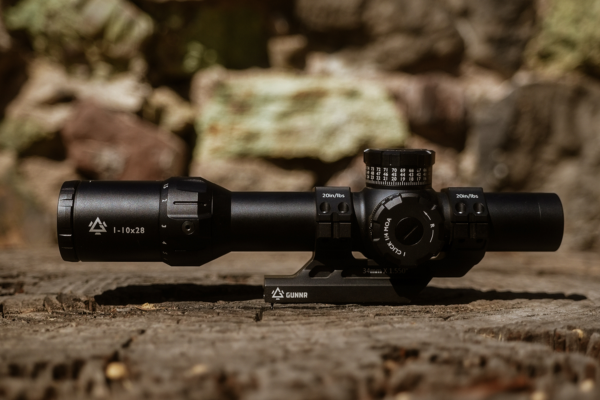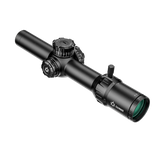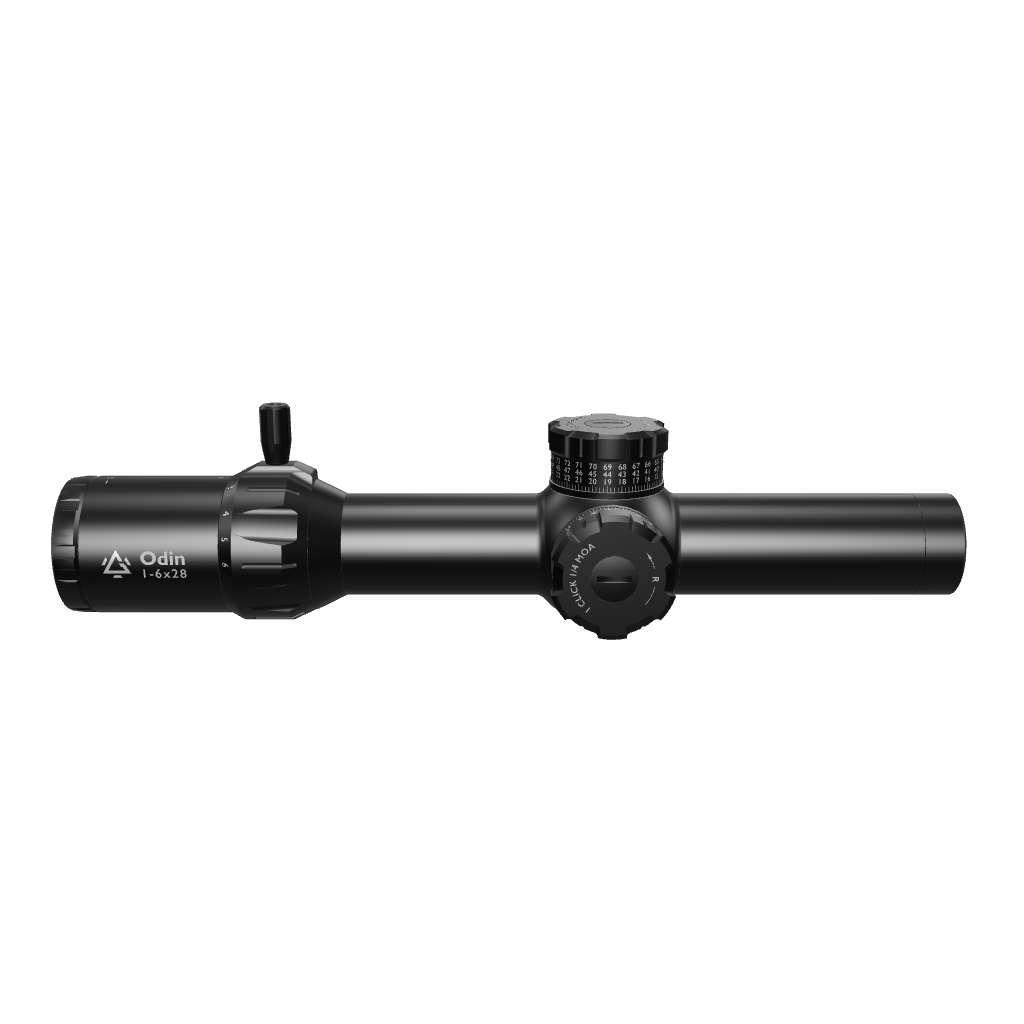LPVO vs MPVO vs HPVO (Choosing the Right Scope)
LPVOs, MPVOs, and HPVOs are all different types of variable magnification optics, but each one is very different from the other in terms of magnification range, strengths, and best use cases.
L.P.V.O, M.P.V.O, and H.P.V.O stand for “Low Power Variable Optics”, “Mid Power Variable Optics”, and “High Power Variable Optics”, respectively — and each one is purpose-built for specific shooting styles and scenarios.
We’ll break down the key differences between these scope types, explain when and why you'd use each one, and provide practical tips to help you make the right choice, whether you're a beginner or an experienced shooter.
LPVO, MPVO, and HPVO Meaning Defined
An LPVO is a variable magnification scope that starts at true 1x magnification and tops out at 4x, 8x, or 10x, making it ideal for close to mid-range fast shooting. Here’s how to tell an LPVO apart from an MPVO or HPVO
- Magnification range for an LPVO is typically 1-4x, 1-6x, or 1-8x, or 1-10x
- An LPVO is best for short to mid-range engagements
- The strengths of an LPVO include fast target acquisition, efficiency in dynamic/tactical shooting.
Though LPVO meaning encompasses a lot more, these are the main features and a basis for understanding how to best use an LPVO.
MPVO (Mid Power Variable Optic)
An MPVO is also a variable magnification optic with a low-end magnification of around 2x–3x and a high-end of around 10x–15x, offering a great balance of range and speed.
The main difference between an MPVO and an LPVO is that the MPVO does not offer true 1x magnification. Though low-end, its magnification range usually starts at 2x or 3x.
Here’s how to tell an MPVO apart from an LPVO and an HPVO
- Magnification Range: 2-10x, 3-12x, or similar
- Best for: Mid-range precision with flexibility for short-range or longer-range shots
- Strengths: Balanced performance — good zoom without excessive weight.
The topic of LPVOs vs MPVOs can be rather complex, with some users arguing that a 2x-10x variable scope should be classified as an LPVO. However, a 2x–10x scope is considered a Mid Power Variable Optic (MPVO), not an LPVO. Here’s why:
- LPVOs are defined by their true 1x low-end magnification. A scope that starts at 2x doesn't qualify, since it lacks that true 1x capability essential for CQB and fast acquisition at close range.
- Most rifle scope manufacturers, including Vortex Optics, Burris Optics, and Gunnr, have answered the question of “what is an LPVO?” They all define it as starting from 1x magnification.
A 2-10x scope is an MPVO, offering more magnification for mid-range shooting while sacrificing the true close-quarters functionality of an LPVO. It’s ideal for shooters who prioritize flexibility over speed.
HPVO (High Power Variable Optic)
The question of “what is an HPVO” is becoming of major interest to more and more shooters around the world.
HPVO stands for “High Power Variable Optic”, a high-magnification scope, often starting at 4x-6x and going up to 16x, 25x+, and designed specifically for long-range precision.
Compared to an LPVO and an MPVO, the HPVO offers the highest magnification (up to 35x) and is best for long-range and precision shooting.
- Magnification Range: Typically, 4-16x, 5-25x, or even 6-36x
- Best for long-range precision shooting, hunting, sniper/DMR applications
- Strengths: High magnification for long-distance identification and accuracy.
LPVO vs MPVO vs HPVO: Key Differences at a Glance
| Feature | LPVO | MPVO | HPVO |
| Magnification Range | 1x to 6x/8x/10x | 2x/3x to 10x/12x | 4x/5x to 16x/25x+ |
| Eye Relief | Generous, quick-acquiring | Moderate, more precise | Tighter, position-sensitive |
| Weight | Light to moderate | Moderate | Heavy |
| Field of View | Wide | Balanced | Narrow at high magnification |
| Reticle Style | Often illuminated BDC | Mixed (BDC, MRAD/MOA) | Precision-focused, MRAD/MOA |
| Best for | CQB, AR-15, 3-Gun comps | Versatile tactical/hunting | Long-range shooting/sniping |
Choosing Between an LPVO, MPVO, and HPVO
Choose an LPVO for Tactical Applications
Choose an LPVO if you prioritize speed over magnification and don’t expect to shoot past 300-400 yards. An LPVO is fast and flexible: ideal for:
- Tactical shooting & home defense
- 3-Gun competitions
- Law enforcement patrol rifles
- Dynamic CQB + outdoor transitions
Why choose an LPVO For Tactical Applications?
- LPVOs allow you to run true 1x magnification, like a red dot, but quickly dial up to 6x or 8x if targets appear at distance.
- Great for AR-platform rifles where agility and speed are critical.
- The best LPVOs come with illuminated reticles, making them highly effective in low light or indoors.
Choose an MPVO for more balanced performance and Increased Versatility
It can handle both tactical and precision roles, especially when paired with a lightweight rifle, which makes it ideal for:
- General-purpose rifles
- Hunting (medium to large game)
- SPRs (Special Purpose Rifles)
- Tactical marksmen and patrol rifles
Why choose an MPVO?
Think of the MPVO as a sweet spot: enough low-end magnification for situational awareness, but enough high-end power to push out to 600+ yards. It is an excellent choice for shooters who want to stretch their legs past LPVO range without carrying a scope that feels like a telescope.
HPVO: Long-Range Dominator
If you're regularly engaging targets at 600 yards or more, HPVOs provide the detail, clarity, and precision you need. HPVOs are ideal for:
HPVOs are Best for Precision rifle competitions (PRS, NRL)
- Sniper or designated marksman roles
- Long-range hunting (elk, mule deer, etc.)
- Shooting steel or targets at 800+ yards
These scopes typically offer advanced reticles (MRAD/MOA grids, Christmas tree-style holds) for dialing in elevation and wind. Perfect for bolt-action rifles and long-barreled AR-10 platforms, and a perfect choice for getting into long-range shooting.
How to Choose the Right Optic (Especially If You're New)
If you’re unsure which category fits you, here are simple questions to guide your decision:
1. How far do you (realistically) shoot?
- 0–300 yards → LPVO
- 100–600 yards → MPVO
- 400–1000+ yards → HPVO
2. How important is speed and field of view?
- Need speed and awareness → LPVO
- Need balance → MPVO
- Need details over speed → HPVO
3. What kind of rifle are you using?
- AR-15 (5.56/.223) → LPVO or MPVO
- AR-10 / .308 → MPVO or HPVO
- Bolt-action rifle → MPVO or HPVO
4. Do you hunt, compete, or train tactically?
- 3-Gun/CQB/Home Defense → LPVO
- Tactical/Field Use/Spring hunting → MPVO
- Long-range/Backcountry/Precision comps → HPVO
Recommended LPVOs
How to Choose the Best LPVO, MPVO, or HPVO
No matter what power range you choose, these features are universally important:
- Clear glass and lens coatings. The German Shott ED Glass used in Gunnr’s LPVOs/HPVOs features an extra-low dispersion (ED) glass element with advanced fully multi-layer coatings, making it easier to spot details and stay locked onto your target, whether at dawn, dusk, or midday.
- Durable construction: Look for shockproof, waterproof, and fog-resistant designs. The Gunnr LPVOs and HPVOs all have an IP67 water resistance rating. You can shoot in temperatures as low as -59°F or as high as 149°F.
- Suitable Reticle design: Choose a reticle type that matches your shooting style (simple for LPVOs, more detailed for MPVO/HPVO). With extended 1 MOA hash marks, the Christmas tree reticle design used in these is easy to use and facilitates accuracy for windage and elevation adjustments.
- Turret precision: Reliable turrets with tactile and audible clicks are essential, especially for MPVOs and HPVOs. Go for turrets with a zero-stop function and audible tactile feedback.
- Weight and balance: Ensure the optic matches your rifle’s ergonomics and purpose.
Final Thoughts: LPVO vs MPVO vs HPVO
Each optic category has a clear role:
- LPVOs shine in fast-paced, short-range scenarios, they’re the red-dot killers.
- MPVOs are the best “do-it-all” scopes: flexible, balanced, and suited for general use.
- HPVOs are purpose-built for long-range precision, and they deliver — but only if you need that power.
If you're new to rifle optics, don’t fall into the trap of thinking "more magnification is always better." The right optic is the one that fits your shooting style, your environment, and your rifle.
If you want a guide on what magnification range estimates look like in real life, here is a scope magnification distance chart.







